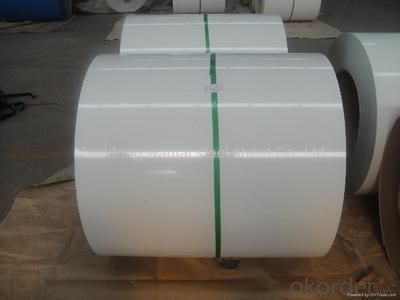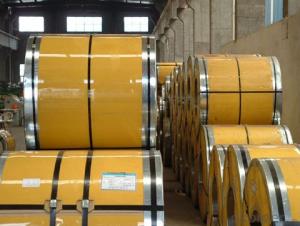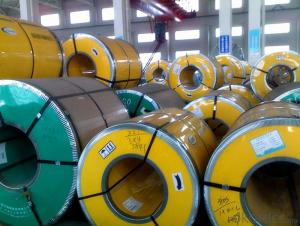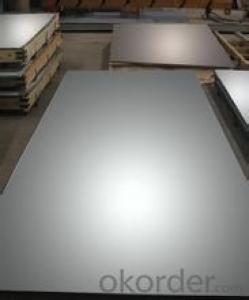PPGI/PPGL steel Coils Or Sheets With Good Quality
- Loading Port:
- Qingdao
- Payment Terms:
- TT OR LC
- Min Order Qty:
- 25 m.t.
- Supply Capability:
- 30000 m.t./month
OKorder Service Pledge
OKorder Financial Service
You Might Also Like
PPGI/PPGL steel Coils Or Sheets With Good Quality
1.Structure of PPGI/PPGL steel Coils Or Sheets With Good Quality
1PPGI/PPGL steel Coils Or Sheets With Good Quality is coated with organic layer, which provides higher anti-corrosion property and a longer lifespan than that of galvanized steel sheets.
2. The base metals for Color Coated Steel Coil consist of cold rolled, HDG electro-galvanized and hot-dip alu-zinc coated steel. The finish coats of Color Coated Steel Coil can be classified into groups as follows: polyester, silicon modified polyesters, polyvinylidene fluoride, high-durability polyester, etc.
3. The production process has evolved from one-coating-and-one-baking to double-coating-and-double-baking, and even three-coating-and-three-baking.
4. The color of the Color Coated Steel Coil has a very wide selection, like orange, cream-colored, dark sky blue, sea blue, bright red, brick red, ivory white, porcelain blue, etc.
5. The Color Coated Steel Coil can also be classified into groups by their surface textures, namely regular prepainted sheets, embossed sheets and printed sheets.
2.Main Features of PPGI/PPGL steel Coils Or Sheets With Good Quality.
1) Rust-proof
2) Water-proof
3)Durable using
3. PPGI/PPGL steel Coils Or Sheets With Good Quality Images


4. PPGI/PPGL steel Coils Or Sheets With Good Quality Specification
1)Based raw material: Hot rolled steel coils or Cold rolled steel coils
2) Thickness
3) Width
4)Coating mass
5) Spangle
6)Surface treatment
7)Coil inner diameter
8)Painting kind
9)Painting color
10)Painting thickness
5.FAQ of PPGI/PPGL steel Coils Or Sheets With Good Quality
We have organized several common questions for our clients,may help you sincerely:
①How about your company?
A world class manufacturer & supplier of castings forging in carbon steel and alloy steel,is one of the large-scale professional investment casting production bases in China,consisting of both casting foundry forging and machining factory. Annually more than 8000 tons Precision casting and forging parts are exported to markets in Europe,America and Japan. OEM casting and forging service available according to customer’s requirements.
②How to guarantee the quality of the products?
We have established the international advanced quality management system,every link from raw material to final product we have strict quality test;We resolutely put an end to unqualified products flowing into the market. At the same time, we will provide necessary follow-up service assurance.
③Could I have your range of the products?
prepainted galvanized steel coils/ppgi/ppgl
Product | PPGI/PPGL |
Capacity | 30,000 tons/month |
Base material | Hot dipped galvanized steel |
Thickness | 0.12-0.80mm |
Width | 600-1250mm(according to your need) |
Coil Weight | 3-6tons |
Quality | SGCC, DX51D |
Color | RAL No. or customers samples’ color |
Zinc-coating | 60g/m2-180g/m2 |
Coil ID | 508mm/610mm |
Technique | Cold rolled—hot dipped galvanized—color coated |
Painting | Top painting:15~25μm Back painting: 6~10μm |
Tolerance | Thickness: +/-0.02mm Width:+/-2mm |
Shipment time | within 15-45 workdays |
Payment | T/T, L/C at sight |
Packing | Standard export packing |
The special order can be negotiated. | |
- Q:How are steel strips used in the production of agricultural irrigation systems?
- Steel strips are commonly used in the production of agricultural irrigation systems for various purposes such as reinforcing pipes, creating durable brackets and supports, and constructing robust frameworks. These strips provide strength, stability, and longevity to the irrigation systems, ensuring their reliability and efficient operation in agricultural settings.
- Q:How are steel strips processed for surface slitting?
- Steel strips are processed for surface slitting by first unwinding the coil and feeding it through a slitting machine. The machine has circular blades that cut the steel strip into narrower widths. The slitted strips are then rewound into separate coils according to the desired width. This process allows for precise and efficient cutting of steel strips for various applications.
- Q:Are steel strips suitable for the manufacturing of industrial machinery?
- Yes, steel strips are suitable for the manufacturing of industrial machinery. Steel strips are known for their durability, strength, and versatility, making them ideal for constructing various components and structures in industrial machinery. They can be easily formed, shaped, and welded to create complex parts, and their high tensile strength ensures the machinery can withstand heavy loads and harsh operating conditions. Additionally, steel strips offer excellent corrosion resistance, ensuring the longevity and reliability of the machinery.
- Q:Are steel strips suitable for making plumbing fixtures?
- Yes, steel strips can be suitable for making plumbing fixtures. Steel is a durable and strong material that can withstand high pressure and temperature, making it ideal for plumbing applications. Steel strips can be easily formed and shaped into various plumbing fixtures such as pipes, fittings, and valves. Additionally, steel has corrosion-resistant properties, which is crucial for plumbing fixtures that come in contact with water and other corrosive substances. Steel strips are also readily available in different sizes and thicknesses, offering flexibility in designing and manufacturing plumbing fixtures. However, it is important to consider the specific requirements of the plumbing system and consult with experts to ensure that the chosen steel strips meet the necessary standards and regulations for plumbing fixtures.
- Q:What are the different alloying elements used in steel strips?
- There are several alloying elements that are commonly used in steel strips to enhance their properties and performance. These alloying elements include: 1. Carbon: Carbon is the main alloying element in steel strips and it determines the hardness and strength of the material. The higher the carbon content, the harder and stronger the steel becomes. 2. Manganese: Manganese is often added to steel strips to improve their toughness and hardenability. It also helps in reducing the formation of harmful sulfides in the steel. 3. Chromium: Chromium is added to steel strips to increase their corrosion resistance and improve their wear resistance. It forms a thin protective layer of chromium oxide on the surface of the steel, preventing it from rusting. 4. Nickel: Nickel is commonly used in stainless steel strips to enhance their corrosion resistance and improve their toughness. It also helps in maintaining the austenitic structure of stainless steel at high temperatures. 5. Silicon: Silicon is added to steel strips to improve their strength and resistance to oxidation. It also helps in deoxidizing the steel during the manufacturing process. 6. Molybdenum: Molybdenum is often used in steel strips to increase their strength, hardness, and resistance to corrosion. It also improves the steel's ability to withstand high temperatures. 7. Vanadium: Vanadium is added to steel strips to improve their strength, toughness, and wear resistance. It also helps in refining the grain structure of the steel, resulting in improved mechanical properties. 8. Tungsten: Tungsten is used in steel strips to increase their hardness, wear resistance, and high-temperature strength. It also helps in improving the steel's ability to retain its hardness at elevated temperatures. These alloying elements, when added in different proportions, help in tailoring the properties of steel strips to suit specific applications. The choice of alloying elements depends on the desired characteristics required for a particular application, such as strength, hardness, corrosion resistance, or high-temperature performance.
- Q:How are steel strips used in the production of metal nameplates?
- Steel strips are used in the production of metal nameplates as a base material. They provide the necessary strength and durability for the nameplate, while also allowing for easy customization through processes like engraving, embossing, or painting.
- Q:How are steel strips processed for specific applications?
- Steel strips are processed for specific applications through a series of manufacturing steps such as hot rolling, cold rolling, annealing, and coating. These processes help in shaping the steel strips, improving their mechanical properties, and enhancing their corrosion resistance.
- Q:What are the different thickness options for steel strips?
- The thickness options for steel strips can vary widely depending on the specific application and requirements. They can range from very thin strips, as thin as 0.001 inches, to much thicker options, exceeding 1 inch in thickness. The desired thickness is determined by factors such as the intended use, structural requirements, and manufacturing processes.
- Q:How do steel strips compare to other materials in terms of strength?
- Steel strips are known for their exceptional strength compared to other materials. Steel has a high tensile strength, enabling it to withstand heavy loads and resist deformation better than most other materials. Additionally, steel's strength remains relatively consistent over a wide range of temperatures, making it highly durable in various conditions. Thus, steel strips are considered a superior choice when strength is a crucial factor in applications.
- Q:What are the common quality control measures for steel strips?
- Some common quality control measures for steel strips include visual inspection for surface defects, dimensional measurements to ensure accurate thickness and width, mechanical testing to assess strength and durability, and chemical analysis to verify composition and purity. Additionally, non-destructive testing methods like ultrasonic or magnetic particle inspection may be used to detect internal or subsurface defects.
1. Manufacturer Overview |
|
|---|---|
| Location | |
| Year Established | |
| Annual Output Value | |
| Main Markets | |
| Company Certifications | |
2. Manufacturer Certificates |
|
|---|---|
| a) Certification Name | |
| Range | |
| Reference | |
| Validity Period | |
3. Manufacturer Capability |
|
|---|---|
| a)Trade Capacity | |
| Nearest Port | |
| Export Percentage | |
| No.of Employees in Trade Department | |
| Language Spoken: | |
| b)Factory Information | |
| Factory Size: | |
| No. of Production Lines | |
| Contract Manufacturing | |
| Product Price Range | |
Send your message to us
PPGI/PPGL steel Coils Or Sheets With Good Quality
- Loading Port:
- Qingdao
- Payment Terms:
- TT OR LC
- Min Order Qty:
- 25 m.t.
- Supply Capability:
- 30000 m.t./month
OKorder Service Pledge
OKorder Financial Service
Similar products
New products
Hot products
Related keywords



























